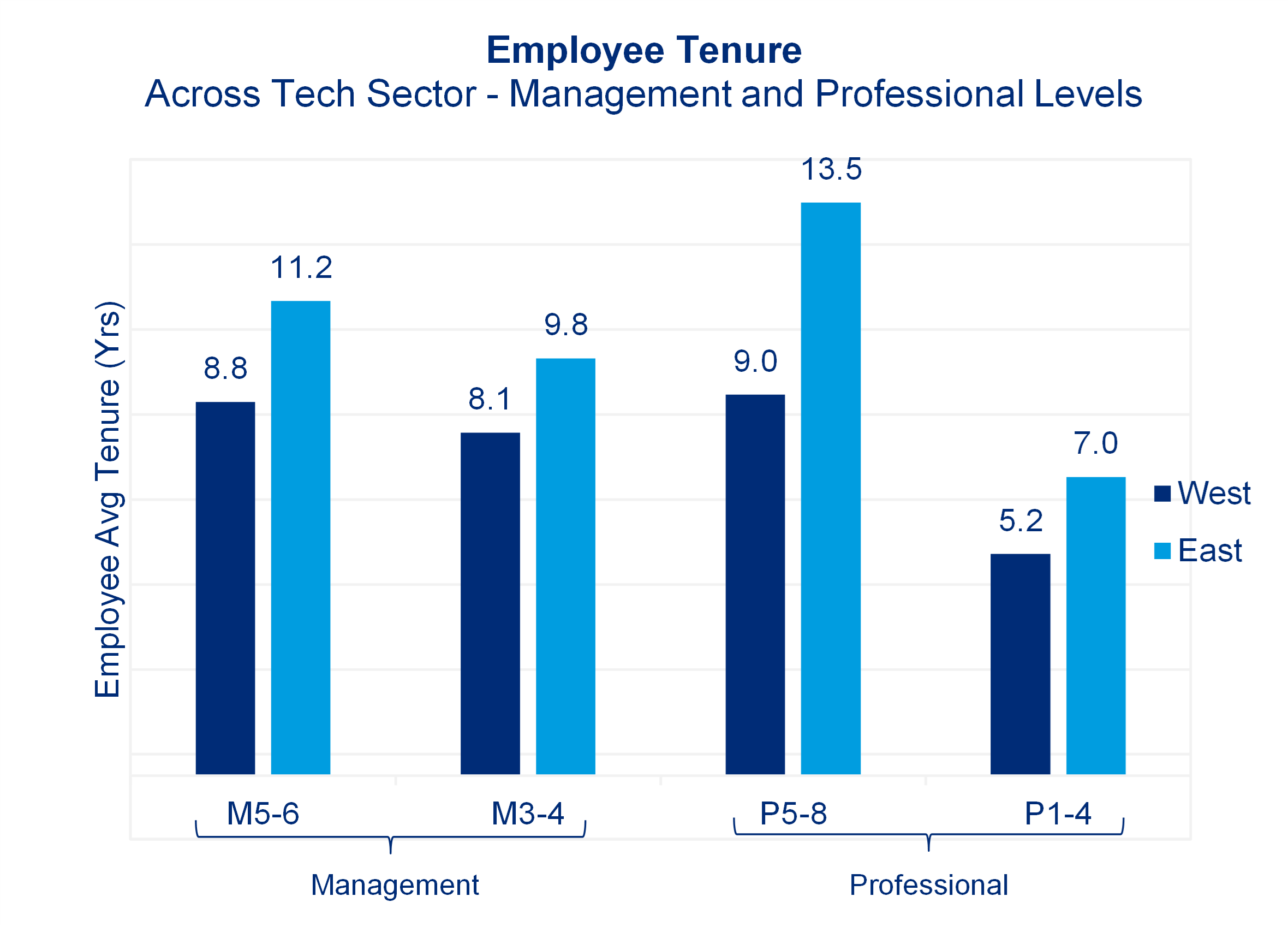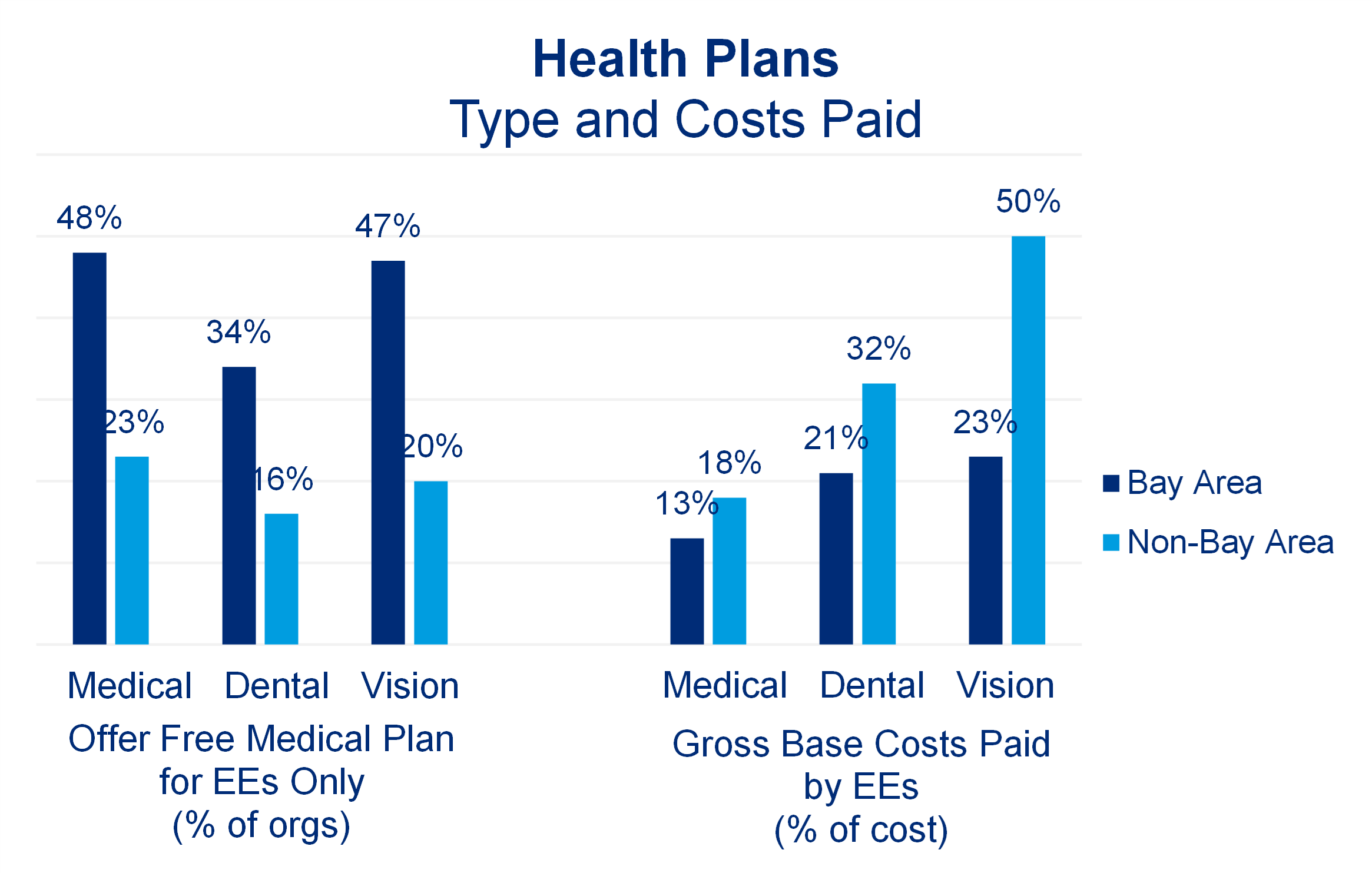A comparative analysis of Total Rewards offerings within the tech industry
HR leaders have a difficult role: attract and retain top tech talent while optimizing ROI and aligning with the company’s broader strategy.
For years, Silicon Valley and the Bay Area have driven the scope of Total Rewards within tech. As a result of this legacy, most Total Rewards offerings are similar across the West and East Coasts in the tech industry. However, understanding the regional differences across three key components should inform your organization’s approach to talent: equity usage, employee development programs, and benefits. The equity eligibility can be different for the West vs. East Coast. Recognizing the differences will allow you to define your talent market and decide how you want to compete.
In this article, we highlight a few key tech industry differences between the West and East Coasts. This isn’t about geography, but rather about helping you decide whether it’s worth making any changes based on your region’s distinct talent market, and equipping you with talking points on where your organization might already stand out.
The following are some of the cities that host the major tech hubs on each coast.
West Coast tech hub cities (think Silicon Valley and the Bay Area)
- San Francisco
- San Jose
- Palo Alto
- Menlo Park
- San Diego
- Reno
- Salt Lake City
- Portland
- Seattle
East Coast tech hub cities:
- Boston
- New York
- Washington, DC
- Philadelphia
- Atlanta
- Raleigh
- Durham
- Chapel Hill
- Charlotte
- Miami
Equity awards: a tale of two coasts
Equity is a category of long-term incentive vehicles. It plays a critical role in the Total Rewards strategies in most tech companies. Equity aligns the interests of employees with shareholders, supports retention, and allows companies to offer a competitive pay package without relying solely on cash compensation. In the tech industry more than any other industry, candidates and employees expect that equity will be part of their compensation.
Equity eligibility and receivership
Data from Mercer | Comptryx confirm that both equity eligibility and receivership are notably higher at West Coast firms compared to their East Coast counterparts. The snapshot below shows a comparison within the Software industry.
In Mercer’s 2024 Tech Total Rewards Survey we found more evidence supporting these disparities:
- 39% of companies in the Bay Area (West Coast) grant equity to all employees, vs.
- Only 18% of companies outside the Bay Area (including East Coast) grant equity to all employees.
For those companies that limit participation, job level is the primary criterion for determining equity eligibility, followed by full-time versus part-time status.
Pay Mix
An employee’s pay package includes a mix of pay delivered proportionally in base salary, annual bonuses, and equity. Comparing the pay mix between the West and East Coasts clearly illustrates differences in equity usage. Findings from Mercer | Comptryx indicate that equity comprises a larger portion of the pay mix for West Coast tech companies. This difference is evident across levels within the Management and Professional tracks, with equity generally comprising an additional 6%–8% of the pay mix among West Coast companies.
Explaining the difference
The disparity in equity eligibility, receivership, and pay mix can be attributed to several factors:
- West Coast tech companies, particularly those in Silicon Valley, operate in a highly competitive environment where attracting and retaining top talent is critical. As a result, they tend to offer more generous equity packages as part of their compensation strategy. This approach not only incentivizes high performance but also aligns employee interests with the long-term success of the company and encourages retention through the vesting period.
- West Coast employees are more likely to be familiar with equity and expect it as part of their compensation. In contrast, East Coast firms often prioritize different compensation structures, focusing more on base salary and annual bonus, which can lead to lower equity participation. Likewise, in our experience, East Coast employees are generally less likely to expect, or even understand, equity outside of certain roles.
Employee development: performance management and tuition assistance
When it comes to long-term employee development, East Coast tech companies adopt a more structured approach compared to their West Coast counterparts. This difference is evident in both performance management and employee development practices, which reflect the distinct corporate cultures and strategic priorities of each region.
Performance management
The prevailing approaches to performance management for tech companies often differ across the coasts. East Coast tech companies generally use a more traditional, once-per-year approach that is aligned with other industries, while West Coast companies tend to experiment more, often eschewing annual cycles for a continuous feedback model.
Let’s look at a few examples:
West Coast:
- Roblox, headquartered in Silicon Valley, takes an agile approach to performance management to support their rapidly evolving workforce. Instead of a job level–based system of promotions, Roblox employs a continuous progression system that recognizes smaller steps in the career journey and formulaically ties contributions to rewards. Each employee’s performance is assessed on a quarterly basis, and their contributions are rated on a scale from 1 to 36. The progression model creates opportunities for more frequent compensation adjustments, creating a more direct and timely connection between performance and pay through base pay adjustments and quarterly equity refresh grants.
- Netflix takes this even further with its culture of frequent feedback and lack of a formal performance management process. Netflix’s Keeper Test policy encourages managers to continuously evaluate whether they would rehire an employee. If the answer is no, the employee is let go. This high-autonomy, high-accountability environment encourages rapid decision-making and innovation but lacks structured growth opportunities that some employees seek.
East Coast:
- One of Mercer's clients is a mid-size tech company on the East Coast. Their performance program is relatively traditional, with a full-year performance period that concludes with a self-assessment, manager assessment, and a series of robust calibration sessions. This culminates in a final performance rating, and compensation decisions are made annually on the basis of that rating. There are quarterly check-ins that are intended to provide an interim update on progress and ladder up to the final rating. There is a detailed competency framework and guidelines on promotion eligibility and criteria. This level of rigor supports the company’s commitment to fairness, and is feasible because the process is implemented annually. Typical feedback from managers is that there is tremendous thought and care put into the process, but it requires a significant time commitment. Additionally, rewards often feel delayed, given that the rewarded performance may have occurred many months earlier.
- Likewise,IBM, a much larger and mature East Coast company, uses a systematic method for performance management. Performance evaluations are AI-driven and conducted on an annual basis to map employee performance to clear career progression paths. This method aligns with their enterprise-focused, research-heavy business model, ensuring consistency and long-term development of their talent. IBM’s commitment to long-term employee development extends to benefit offerings through a robust tuition assistance program. This is aligned with regional trends observed in Mercer’s Tech Total Rewards Survey: 57% of non–Bay Area companies provide tuition assistance or student loan matching benefits, compared to only 26% of Bay Area companies. Furthermore, companies outside the Bay Area tend to offer a higher amount of tuition assistance on average.
The difference in employee tenure at East and West Coast companies helps contextualize the differences in approach to employee development. Data from Mercer | Comptryx shows that employees in East Coast tech companies tend to have a longer average tenure of around 2 years (and up to 4.5 years for senior-level individual contributors). This may lead companies to put more focus on long-term development, which in turn can further motivate employees to remain at the company longer, enabling them to meet their development goals.

Overall, the differences in employee development between the coasts reflect broader cultural and strategic priorities. West Coast tech firms focus on creating a culture of innovation and rapid evolution, which puts the onus on employees to chart their own career journey and may lead to higher attrition. In contrast, East Coast firms tend to invest more in career development through robust structured processes and programs. This allows East Coat firms to build a pipeline for their future workforce while also addressing employees’ desires to meet their career goals.
Medical, dental, and vision plan costs: a healthier approach
Cost sharing for health benefits is another area of Total Rewards where we see a difference between the coasts. When it comes to medical, dental, and vision plans, the Tech Total Rewards Survey indicates that Bay Area companies are more likely to offer “free” plans with no employee contributions for employee-only coverage and employees of Bay Area companies pay a lower portion of the gross healthcare costs. This approach reflects the competitive nature of the tech talent market in the Bay Area and addresses what employees value. Mercer’s 2024-2025 Inside Employees’ Minds Survey indicates that healthcare benefits are ranked as the #2 offering that attracts and retains employees at organizations within the Tech industry, and the broader market.

The West Coast's focus on health benefits is shaped by the region's culture, which emphasizes health and wellness. This cultural priority encourages companies to adopt practices that promote work-life balance and employee well-being as core elements of their corporate ethos. As a result, employees in the region often expect free coverage and low healthcare costs to be part of their Total Rewards package.
Closing thoughts
As we’ve discussed, while East and West Coast tech companies share many similarities, differences in equity usage, employee development, and benefits highlight regional nuances. Understanding these distinctions can help you attract and retain talent. Ultimately, whether your company is on the East or West Coast, success depends on how you choose to position your organization to build and communicate an employee value proposition that truly resonates with your workforce.
Across both coasts, HR leaders like you are taking proactive steps, including:
1. Reviewing their Total Rewards offerings through employee engagement surveys, data on actual employee program usage, and external market practices.
2. Using the information to identify what employees value most while considering cost optimization and overall ROI.
3. Actively driving an impactful talent strategy based on what they have learned.
Based on a clear understanding of these regional differences, you can develop a Total Rewards strategy that is uniquely suited to your organization. This will require listening to your employees and leaders, optimizing costs to deliver the highest ROI, and ultimately celebrating the success of your changes as you implement them broadly to retain and attract top talent.
Need help determining the right Total Rewards strategy for your tech talent? We’ve got experts waiting to partner with you! Call us at 855-286-5302 or email surveys@mercer.com.
About the Authors
Juliet Archer, Senior Principal
Juliet Archer is a Senior Principal in Mercer’s Career business in Los Angeles. Juliet specializes in incentive design, executive compensation, and skills-based job architecture. Her passion is helping clients align their incentives with their business strategy to drive results.
Yelena Brodbeck, Senior Principal
Yelena is a Senior Principal in Mercer’s Career practice in New York. She works across executive and workforce rewards, having previously led compensation and total rewards at a tech company. She enjoys working with clients to maximize the impact and value they get from their total rewards offerings.